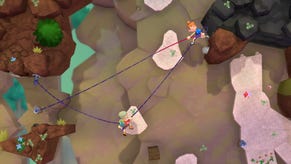Crackdown As You've Never Seen It Before
A technical retrospective with HD video.
In the second video below, we aim to stress the Crackdown engine to breaking point, pushing GPU and CPU to the limits with a range of blasts, building up from basic explosions to a full-on in-game armageddon. Checking out the physics engine at work is a pleasure in itself... we've slowed the game video down to 50% speed, all the better to show Crackdown works, as well as revealing the full impact of the lack of v-sync (torn frames are indicated by vertical green lines at the base of the graph). What is surprising is just how well the engine handles itself during the carnage. Yes, the game tears in strenuous scenes, and frame rate can dive to 10FPS in a worst-case scenario. But in the majority of actual gameplay scenarios, Crackdown acquits itself with a strong 30FPS refresh rate and little tearing.
You'll note that the game employs a low-resolution alpha buffer when dealing with explosions - resulting in an upscaled look on the blasts, which also afflicts scenery and objects in the same area. This saves on both bandwidth and fill-rate and keeps the game running smoothly. This technique is used in games like Killzone 2 and the forthcoming Red Faction Guerrilla (well, the PS3 version at least). What is very cool though is how the orange tint of a secondary blast affects the smoke effect from the primary explosion - not often we see this even today, and an instrumental part of making the destruction in Crackdown look so appealing.
Perhaps the most remarkable thing about Crackdown is that the entire shebang is based on an engine that has had limited exposure on Xbox 360 and barely any kind of fanfare since the PS2 days. The core underpinnings of the game are based on Criterion's RenderWare platform - tech that has powered titles as diverse as the Burnout games and the last generation GTA series. Since the programmers behind the engine are now part of Electronic Arts, the code is no longer licensed, and Crackdown stands alone as the only non-EA title to use it on the current generation platforms.
Clearly though, Realtime Worlds adapted the engine significantly to get Crackdown looking as good as it does. The deferred renderer was all Realtime's work, and numerous effects and performance tweaks were coded up by the talented team. Indeed, initial development actually begun on the first generation Xbox, where decals, streaming, memory consumption and some severe optimisations for open-world gameplay were carried out before the project was moved onto Xbox 360. This suggests that development itself started during 2003, making Crackdown the result of three to four years' work.
As January 2009, development on an alleged sequel has been ongoing at start-up Scottish development house, Ruffian Games. Little is known about it, though some have described it as a multiplayer-only revision of the first game. The developer itself refuses to comment, saying only that the game has a heavy online component. Of course we'd like to see the engine significantly retooled to catch up with and exceed the likes of inFamous, but the real question is, does it actually have to? The cartoon-esque stylings of the game gives the developer a lot of licence, and the game itself is held in such regard that a "more of the same" approach with a beefed up online component will be more than enough to keep the fans happy. But we can't help wishing for something more...
Do you want to know more? Keep up to date with all matters technical and performance-related in the Digital Foundry channel.






.jpg?width=291&height=164&fit=crop&quality=80&format=jpg&auto=webp)
